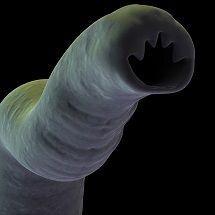Article
“Hookworm Soup†a Potent Asthma Solution?
Author(s):
Hookworms aren't the common affliction that they once were, at least in the developed world, but asthma prevalence is growing. A new study winks at a correlation, suggesting that a protein in the pesky parasites may treat asthma.

Once a common unseen scourge, parasitic hookworm infections are rare these days in developed nations. Increasingly common, however, are inflammatory conditions such as asthma. A new study may wink at a correlation between those two trends along the way to suggesting that a protein secreted by hookworms may reduce asthma symptoms.
Published this week in Science Translational Medicine, the study from researchers at Australia’s James Cook University pinpoints the substance, anti-inflammatory protein-2 (AIP-2), as the molecule of interest. After freezing a suspension of the worms in a petri dish, it was observed that the most prevalent protein in the liquid suspension was AIP-2. Because of the relative rarity of the worms, it was easier for the researchers to reproduce AIP-2 on their own than to constantly extract it.
When the so-called “soup” was injected into animal models of various diseases, great benefit was observed.
The protein was found to significantly suppress airway inflammation. One of the researchers, Severine Navarro, says that mice with a model of asthma saw “almost a complete reversal of the disease.”
In addition to suppressing airway inflammation responses, the AIP-2 “suppressed proliferation ex vivo of T cells from human subjects with house dust mite allergy,” according to the study.
Navarro describes the novelty of the research: “you put your cowboy hat on and go for it.” As far as using parasites for medical purposes, this is a far cry from applying leeches to rid patients of real or imagined ailments (an art that is apparently making a comeback). While the researchers acknowledge a “yuck” factor, the treatment is more focused on the protein variety than the worms themselves.
“Our findings indicate that recombinant AIP-2 could serve as a novel curative therapeutic for allergic asthma and potentially other inflammatory diseases,” concludes the study.
Related Coverage:
Imagining a Vaccine for Asthma
Technology Tweaks Asthma Self-Management Programs for Adolescents





